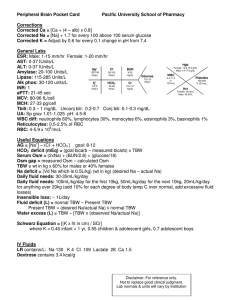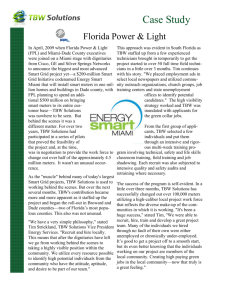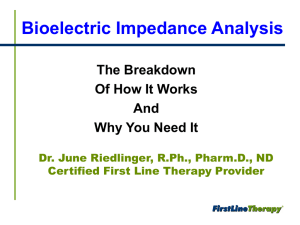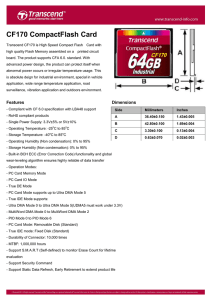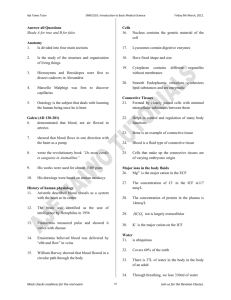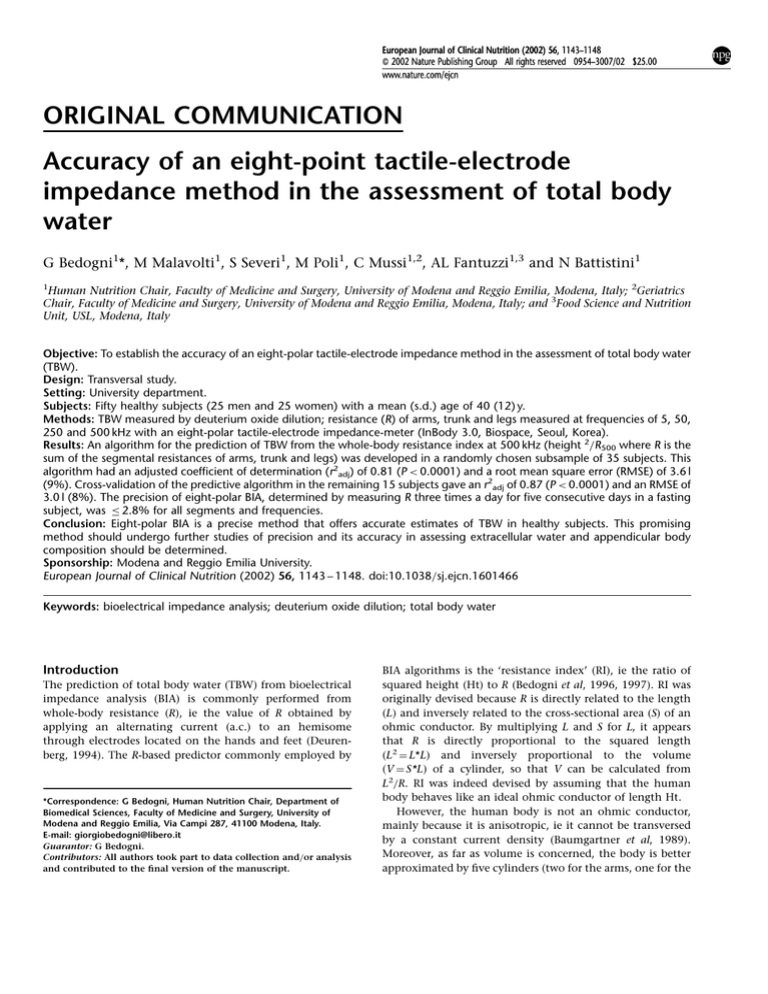
European Journal of Clinical Nutrition (2002) 56, 1143–1148
ß 2002 Nature Publishing Group All rights reserved 0954–3007/02 $25.00
www.nature.com/ejcn
ORIGINAL COMMUNICATION
Accuracy of an eight-point tactile-electrode
impedance method in the assessment of total body
water
G Bedogni1*, M Malavolti1, S Severi1, M Poli1, C Mussi1,2, AL Fantuzzi1,3 and N Battistini1
1
Human Nutrition Chair, Faculty of Medicine and Surgery, University of Modena and Reggio Emilia, Modena, Italy; 2Geriatrics
Chair, Faculty of Medicine and Surgery, University of Modena and Reggio Emilia, Modena, Italy; and 3Food Science and Nutrition
Unit, USL, Modena, Italy
Objective: To establish the accuracy of an eight-polar tactile-electrode impedance method in the assessment of total body water
(TBW).
Design: Transversal study.
Setting: University department.
Subjects: Fifty healthy subjects (25 men and 25 women) with a mean (s.d.) age of 40 (12) y.
Methods: TBW measured by deuterium oxide dilution; resistance (R) of arms, trunk and legs measured at frequencies of 5, 50,
250 and 500 kHz with an eight-polar tactile-electrode impedance-meter (InBody 3.0, Biospace, Seoul, Korea).
Results: An algorithm for the prediction of TBW from the whole-body resistance index at 500 kHz (height 2=R500 where R is the
sum of the segmental resistances of arms, trunk and legs) was developed in a randomly chosen subsample of 35 subjects. This
algorithm had an adjusted coefficient of determination (r2adj) of 0.81 (P < 0.0001) and a root mean square error (RMSE) of 3.6 l
(9%). Cross-validation of the predictive algorithm in the remaining 15 subjects gave an r2adj of 0.87 (P < 0.0001) and an RMSE of
3.0 l (8%). The precision of eight-polar BIA, determined by measuring R three times a day for five consecutive days in a fasting
subject, was 2.8% for all segments and frequencies.
Conclusion: Eight-polar BIA is a precise method that offers accurate estimates of TBW in healthy subjects. This promising
method should undergo further studies of precision and its accuracy in assessing extracellular water and appendicular body
composition should be determined.
Sponsorship: Modena and Reggio Emilia University.
European Journal of Clinical Nutrition (2002) 56, 1143 – 1148. doi:10.1038=sj.ejcn.1601466
Keywords: bioelectrical impedance analysis; deuterium oxide dilution; total body water
Introduction
The prediction of total body water (TBW) from bioelectrical
impedance analysis (BIA) is commonly performed from
whole-body resistance (R), ie the value of R obtained by
applying an alternating current (a.c.) to an hemisome
through electrodes located on the hands and feet (Deurenberg, 1994). The R-based predictor commonly employed by
*Correspondence: G Bedogni, Human Nutrition Chair, Department of
Biomedical Sciences, Faculty of Medicine and Surgery, University of
Modena and Reggio Emilia, Via Campi 287, 41100 Modena, Italy.
E-mail: giorgiobedogni@libero.it
Guarantor: G Bedogni.
Contributors: All authors took part to data collection and=or analysis
and contributed to the final version of the manuscript.
BIA algorithms is the ‘resistance index’ (RI), ie the ratio of
squared height (Ht) to R (Bedogni et al, 1996, 1997). RI was
originally devised because R is directly related to the length
(L) and inversely related to the cross-sectional area (S) of an
ohmic conductor. By multiplying L and S for L, it appears
that R is directly proportional to the squared length
(L2 ¼ L*L) and inversely proportional to the volume
(V ¼ S*L) of a cylinder, so that V can be calculated from
L2=R. RI was indeed devised by assuming that the human
body behaves like an ideal ohmic conductor of length Ht.
However, the human body is not an ohmic conductor,
mainly because it is anisotropic, ie it cannot be transversed
by a constant current density (Baumgartner et al, 1989).
Moreover, as far as volume is concerned, the body is better
approximated by five cylinders (two for the arms, one for the
TBW by 8-polar BIA
G Bedogni et al
1144
trunk and two for the legs) than by a single cylinder (Kushner, 1992). Because R is inversely related to S, arms and legs
contribute more than trunk to whole-body R (Baumgartner
et al, 1989). This has led to the suggestion that segmental RI
(obtained by dividing the squared L of a segment by its
resistance) may be more appropriate than whole-body RI to
predict body composition (Baumgartner et al, 1989).
Only two studies have been performed so far as the
prediction of TBW from segmental RI is concerned and in
both of them R was measured at a single frequency of 50 kHz
(Organ et al, 1994; Wotton et al, 2000). From the data of
Organ et al (1994), a standard error of the estimate (s.e.e.) of
7% can be calculated for the prediction of TBW from wholebody RI in men and women. The corresponding value for the
prediction of TBW from segmental RI (arms, trunk and legs)
is 7% for men and 6% for women. From the data of Wotton
et al (2000), an s.e.e. of 10% can be calculated for the
prediction of TBW from whole-body RI and one of 9% for
the prediction from segmental RI (arms, trunk and legs) in
both men and women.
Recently, an eight-point tactile-electrode impedancemeter was developed and made available (InBody 3.0, Biospace, Seoul, Korea). We found this method attractive for two
reasons: (1) the use of tactile electrodes for measuring segmental resistances at multiple frequencies; and (2) the
absence of need to standardize the subject’s posture before
BIA. These characteristics have the potential to reduce
measurement times and make this instrument ideal
for epidemiological studies. This is especially true when
subject’s posture is considered, because 10 – 15 min are
needed to standardize fluid distribution with four-polar
BIA (Deurenberg, 1994).
This study aimed therefore at evaluating the accuracy of
eight-polar BIA for the assessment of TBW.
Materials and methods
Subjects
Fifty healthy subjects (25 males and 25 females) with a mean
(s.d.) age of 40 (12) y were enrolled in the study. They were
recruited mainly among the personnel working at the
Department of Biomedical Sciences of Modena and Reggio
Emilia University. Inclusion criteria were: (1) age 18 y; (2)
body mass index (BMI) > 18.5 kg=m2 (ie not underweight)
and BMI < 30.0 kg=m2 (ie not obese); (3) absence of chronic
(eg diabetes) and acute (eg influenza) disease, as determined
by clinical history and physical examination; and (4) menstrual cycle between the 1st and 15th day for women. The
study procedures had been approved by the local Ethical
Committee and all subjects gave informed consent.
Anthropometry
All anthropometric measurements were performed by the
same operator following the Anthropometric Standardization
Reference Manual (Lohman et al, 1988). Weight (Wt) was
European Journal of Clinical Nutrition
measured to the nearest 100 g and total body height (Ht) to
the nearest 0.1 cm using an electronic balance with an
incorporated stadiometer (Tanita, Tokyo, Japan). BMI was
calculated as Wt (kg)=Ht (m)2. Acromial height and sitting
height were measured using a portable anthropometer (Holtain, Crymich, UK). Leg length was obtained by subtracting
sitting height from total body Ht, the height of head and
neck by subtracting acromial height from total body Ht, and
trunk height by subtracting the height of head and neck
from sitting height. Arm length was measured as the distance
between the lateral tip of the acromion and a line joining the
bony prominences of radius and ulna on the dorsum of wrist
(Organ et al, 1994). The distance between the line joining the
bony prominences of radius and ulna and the 3rd metacarpal
joint was also measured and summed to arm length in order
to better approximate the true conductor length assumed by
the eight-polar bioelectrical model of the arm. (With eightpolar BIA electrodes are located at the level of thumb and
palm while with four-polar BIA they are positioned at the
wrist level; see below). Triceps skinfold (TSF) and arm
circumference (AC) were measured on the left side to the
nearest 0.1 cm using a skinfold caliper and an anthropometric tape, respectively (Holtain, Crymich, UK).
Arm muscle area (AMA) and arm fat area (AFA) were calculated from AC and TSF as described by Heymsfield et al
(1982).
Eight-polar BIA
R of arms, trunk and legs was measured in fasting subjects at
frequencies of 5, 50, 250 and 500 kHz using an eight-polar
tactile-electrode impedance-meter (InBody 3.0, Biospace,
Seoul, Korea). This instrument makes use of eight tactile
electrodes: two are in contact with the palm (E1, E3) and
thumb (E2, E4) of each hand and two with the anterior (E5,
E7) and posterior aspects (E6, E8) of the sole of each foot
(Figure 1).
The subject stands with her or his soles in contact with
the foot electrodes and grabs the hand electrodes. The
sequence of measurements, controlled by a microprocessor,
proceeds as follows. An alternating current (a.c.) of 250 mA of
intensity (I) is applied between E1 and E5. The recorded
voltage difference (V) between E2 and E4 is divided for I to
obtain the resistance of the right arm (RRA). The same
operation is performed with V recorded between E4 and E8
to obtain the trunk resistance (RT) and with V recorded
between E6 and E8 to obtain the resistance of the right leg
RRL. The a.c. is then applied between E3 and E7 and the value
of V measured between E2 and E4 is used to calculate the
resistance of the left arm (RLA). Lastly, the value of V
measured between E6 and E8 is used to calculate the resistance of the left leg RLL. No precaution was taken to standardize the subject’s posture before BIA, as suggested by the
manufacturer. Values of RI were calculated at all frequencies
as follows:
TBW by 8-polar BIA
G Bedogni et al
1145
collected before the administration of this solution and 4 h
later. Subjects refrained from eating and drinking during the
equilibration period of the tracer. 2H2O concentration in
urine was measured by FT-IR spectrophotometry using the
method of Lukaski and Johnson (1985). TBW was calculated
as (2H2O dilution space*0.95), taking into account nonaqueous distribution of 2H2O (Schoeller, 1996).
Figure 1 Measurement pathways of InBody 3.0 (graph reproduced by
courtesy of Biospace). The subject stands with her or his soles in contact
with the foot electrodes and grabs the hand electrodes. RRA, resistance of
right arm; RT, resistance of trunk; RLA, resistance of left arm; RRL,
resistance of right leg; RLL, resistance of left leg. See text for details.
(1) arm (A)
RIA ¼
arm length (cm)2
RA ðOÞ
RIL ¼
leg length (cm)2
RL ðOÞ
(2) leg (L)
(3) trunk (T)
Results
RIT ¼
trunk height (cm)
RT ðOÞ
2
(4) whole body (SUM)
RISUM ¼
Statistical analysis
Statistical analysis was performed on a MacOS computer
using the Statview 5.1 (SAS, Cary, NC, USA) and SPSS 10
(SPSS, Chicago, IL, USA) software packages. Between-group
comparisons were performed by unpaired t-tests and withingroup comparisons by paired t-tests. Statistical significance
for these tests was set to a value of P < 0.05. Bonferroni’s
correction was applied to between-group and between-hemisome comparisons of R values because of the number of tests
involved. The significant P-value for these comparisons was
put equal to 0.01 (0.05=3) because they were made in three
groups (all subjects, males and females). The adjusted determination coefficient (r2adj), the root mean square error
(RMSE) and the percentage root mean square error
(RMSE% ¼ RMSE=mean value of the dependent variable)
obtained from linear regression of TBW vs RI were used to
determine the accuracy of BIA (Guo et al, 1996; Glantz &
Slinker, 2001). An interaction term between RI and sex (RI*
sex) was added to test the influence of sex on the relationship between TBW and RI. Measured and predicted values of
TBW were also compared using paired t-tests.
The precision of InBody 3.0 was determined by measuring
R three times a day for five consecutive days on one of the
study subjects. The between-day CV [(s.d.=mean)*100] calculated from these measurements (n ¼ 15) are given in Table 1.
According to these values, the precision of InBody 3.0 is
quite good and comparable to that of four-polar total-body
BIA performed at 50 kHz (CV ¼ 3.0% for between-day measurements; Deurenberg, 1994; Heitmann, 1994).
total body Ht (cm)2
RRA ðOÞ þ RLA ðOÞ þ RT ðOÞ þ RRL ðOÞ þ RLL ðOÞ
Deuterium oxide dilution
TBW was measured by deuterium oxide (2H2O) dilution.
Each fasting subject received a precisely weighed solution
made up of 2H2O and drinkable water. Urine samples were
The anthropometric measurements and TBW of the subjects
are given in Table 2.
Age was not significantly different in males and females
(P ¼ 0.47). As expected, men were heavier (P < 0.0001) and
Table 1 Precision of eight-polar BIA. Values are coefficients of variation
calculated from three measurements performed 1 h from each other for
five consecutive days
R5
R50
R250
R500
Trunk
Right arm
Left arm
Right leg
Left leg
2.8
2.2
1.7
2.2
2.0
1.8
1.9
1.8
2.8
2.6
2.3
2.3
2.5
2.3
2.4
2.3
2.5
2.3
2.2
2.0
Rx, resistance at x kHz.
European Journal of Clinical Nutrition
TBW by 8-polar BIA
G Bedogni et al
1146
Table 2 Measurements of the study subjects. Values are means and
standard deviations
n
Age (y)
Wt (kg)
Ht (m)
BMI (kg=m2)
AMA (cm2)
2
AFA (cm )
TBW (l)
TBW:Wt (%)
All
Female
Male
50
40 12
72.7 14.5
1.71 0.09
24.4 3.5
41.7 17.5
28.4 8.5
39.9 8.1
55.9 4.3
25
39 12
62.2 9.8
1.64 0.06
23.0 3.4
27.4 5.8
31.9 8.2
33.9 4.2
54.9 4.5
25
41 12
81.2 12.1***
1.77 0.07***
25.8 3.1*
56.0 12.8***
24.8 7.4**
46.0 6.5***
56.8 3.9
*P ¼ 0.002, **P ¼ 0.004; and ***P < 0.0001 vs female.
Wt, weight; Ht, height; BMI, body mass index; AMA, arm muscle area; AFA,
arm fat area; TBW, total body water.
taller (P < 0.0001) than women, and had higher values of
BMI (P ¼ 0.002), AMA (P < 0.0001) and AFA (P ¼ 0.004).
TBW was higher in males than females (P < 0.0001) but
body hydration, calculated as TBW:Wt, was similar
(P ¼ 0.12). This unexpected finding implies that the study
women had more fat-free tissues per unit of Wt than the
‘average woman’ does. This is supported by the fact that our
women had a BMI lower than average (23.0 kg=m2) and an
inter-individual variability in AMA and AFA comparable to
that of men (CV ¼ 21 vs 23% for AMA and CV ¼ 26 vs 30% for
AFA). The values of R are given in Table 3.
Table 3 Resistance measurements of the study subjects. Values are
means and standard deviations
Resistance (O)
Trunk
Right arm
Left arm
Right leg
Left leg
Sum
5 kHz
50 kHz
250 kHz
500 kHz
27 4
{
365 63
370 66
288 39
290 41
1340 202
21 3
318 58
325 60
253 37
254 39
1171 185
18 3
{
284 54
292 56
226 34
227 36
1046 175
16 3
{
274 52
281 55
219 22
220 34
1011 169
P ¼ 0.004 and {P < 0.0001 vs left side
(statistical significance set to a value of P < 0.01 owing to multiple
comparisons).
{
In the pooled sample, RRA was lower than RLA at frequencies of 5 (P ¼ 0.004), 250 (P < 0.0001) and 500 (P < 0.0001)
kHz but RRL and RLL were not significantly different (Table 3).
R was consistently lower in males than females for all
segments frequencies (P 0.005; data not shown), owing to
their higher TBW. The relationships between R, RI and TBW
are given in Table 4.
R explained a quote of TBW variance comprised between
33 (RT5) and 65% (RRA250, RRA500 and RSUM500). A trend to an
increase in the explained variance of TBW was seen at
increasing frequencies, as expected from electrical theory
(Table 4). The sex*R interaction was significant (P < 0.05)
for limbs and whole body at frequencies 250 kHz (data
not shown). Although this suggests the need to consider
separately males and females, we chose not to do this for
descriptive reasons, for RI allowed a better prediction of TBW
as compared to R alone (Table 4) and none of the sex*RI
interactions was significant (data not shown).
The best prediction of TBW from RI was obtained from
RISUM500 at 500 kHz (r2adj ¼ 0.83, RMSE ¼ 3.4 l, RMSE% ¼ 9%,
n ¼ 50; cf. Table 4). When total body Ht was used instead of
segmental length as the numerator of RI, the results were
unchanged or slightly better (data not shown). This shows
that with eight-polar BIA there is no practical advantage in
using segmental lengths instead of total body height as the
numerator of RI.
It has been suggested that segmental RI may be employed
to predict TBW by means of multiple regression models
(Organ et al, 1994; Wotton et al; 2000). Besides not being
superior to simple regression from RISUM500, this approach
was prone to multicollinearity in our subjects (variance
inflation factors 6.5) and thus we preferred to avoid it.
The presence of multicollinearity was not unexpected
because all RI have length2 as their numerator and the
values of R at their denominator are highly correlated
(Glantz & Slinker, 2001).
Thus, RISUM500 was the best predictor on both theoretical
and practical grounds. In order to develop a predictive
algorithm of TBW based on RISUM500 and test its accuracy,
we randomly split the study sample in two sub-samples.
Following the recommendations of Guo et al (1996), twothirds of the sample (n ¼ 35) were used to generate a predictive equation of TBW from RISUM500 and the remaining
Table 4 Variance of total body water explained by BIA (n ¼ 50). Values are adjusted coefficients of determination
Trunk
Right arm
Left arm
Right leg
Left leg
Sum
R5
RI5
R50
RI50
R250
RI250
R500
RI500
0.33
0.64
0.61
0.48
0.43
0.61
0.56
0.80
0.78
0.73
0.71
0.81
0.47
0.57
0.53
0.55
0.51
0.61
0.66
0.75
0.74
0.76
0.75
0.80
0.44
0.65
0.62
0.57
0.49
0.64
0.64
0.81
0.79
0.78
0.74
0.82
0.41
0.65
0.62
0.56
0.52
0.65
0.63
0.81
0.79
0.78
0.76
0.83
P < 0.0001 for all values.
2
2
Rx, resistance at x kHz; RIx, resistance index (segmental length =R for trunk and limbs, and height =R for sum) at x kHz.
European Journal of Clinical Nutrition
TBW by 8-polar BIA
G Bedogni et al
1147
one-third (n ¼ 15) was used to test its accuracy. The results of
this procedure are shown in Figure 2.
The predictive algorithm based on RISUM500 explained
81% of TBW variance (P < 0.0001) and had an RMSE of
3.6 l (9%). There was no significant difference between
TBW estimated from BIA and TBW measured by 2H2O
(40.6 7.3 vs 40.6 8.1 l; P ¼ 0.99). The validation of the
algorithm proved to be equally good, with an r2adj of 0.87,
a RMSE of 3.0 l (8%), a pure error of 3.1 l and a mean (s.d.)
estimated value of 38.5 (7.5) l vs a measured one of 38.3
(8.2) l (P ¼ 0.99).
Discussion
In this study, we evaluated the accuracy of a newly developed eight-polar tactile-electrode impedance-meter. Making
use of tactile electrodes and requiring no standardization of
the subject’s posture before measurements, this method may
Figure 2 Random generation (A, n ¼ 35) and cross-validation (B, n ¼ 15) of a predictive algorithm for total body water from the whole-body resistance
index at 500 kHz. TBW, total body water; F, female; M, male; RISUM500, resistance index at 500 kHz; RMSE, root mean square error; PE, pure error.
European Journal of Clinical Nutrition
TBW by 8-polar BIA
G Bedogni et al
1148
provide a significant advantage over traditional methods in
epidemiological studies, where time constraints are very
important. However, every instrument should undergo
detailed studies of precision and accuracy before being
employed for research and clinical purposes. Without this
kind of validation, the potential advantages of a given
instrument may remain just theoretical.
It is noteworthy that the right arm of the subjects had
lower values of R compared to the left arm (Table 2). Because
muscles are made of about 80% water (Wang et al, 1999)
and R is inversely proportional to water, the lower R can be
taken as evidence of a more developed musculature in the
right arm. Even if this is in agreement with the fact that the
great majority of subjects were right-handed, this hypothesis
needs to be tested against direct measurements of appendicular muscle mass such as those allowed by dual-energy Xray absorptiometry.
An important finding of this study is that R was strongly
associated by itself with TBW, being able to explain up to 65%
of its variance. These data allow us to respond to an observation raised about the role of BIA in the assessment of body
composition. It has in fact been stated that, for BIA to be
considered a body composition technique, associations of
R — and not RI — with body compartments are to be considered (Mazess, 1991). In this study, RSUM500 contributed
65% of TBW variance (P < 0.0001, n ¼ 50) and its contribution was greater than that of Ht2 (r2adj ¼ 0.56, P < 0.0001).
Moreover, when Ht2 and RSUM500 were combined in the form
of RISUM500, the explained variance of TBW rose to 83%
(P < 0.0001). Thus, even if RI may not be the best descriptor
of the electrical behavior of the human body on theoretical
grounds, its use in predictive models is clearly worth consideration (Kushner, 1992; Kushner et al, 1992). This does not
preclude, however, use of bioelectrical indexes other than RI,
provided that they are shown to offer better estimates of
body composition than RI (Organ et al, 1994).
Using total body Ht instead of segmental lengths as the
numerator of RI did not produce substantial changes in the
explained variance of TBW. Since the measurement of arm
length, trunk height and leg length requires time and effort,
it appears that total body Ht, which is measured with greater
rapidity and precision, can safely replace segmental lengths.
The most accurate and practical way of predicting TBW from
eight-polar BIA is to calculate RI by dividing Ht2 for the sum
of segmental R at 500 kHz (Table 4).
We conclude that the eight-polar tactile-electrode impedance method is precise and gives accurate estimates of TBW
European Journal of Clinical Nutrition
in healthy subjects. This promising method should undergo
further studies of precision and its accuracy in assessing
extracellular water and appendicular body composition
should be determined.
References
Baumgartner RN, Chumlea WC & Roche AF (1989): Estimation of
body composition from bioelectric impedance of body segments.
Am. J. Clin. Nutr. 50, 221 – 226.
Bedogni G, Polito C, Severi S, Strano CG, Manzieri AM, Alessio, M,
Iovene A & Battistini N (1996): Altered body water distribution in
subjects with juvenile rheumatoid arthritis and its effects on the
measurement of water compartments from bioelectric impedance.
Eur. J. Clin. Nutr. 50, 335 – 339.
Bedogni G, Bollea, MR, Severi S, Trunfio O, Manzieri AM & Battistini
N (1997): The prediction of total body water and extracellular
water from bioelectric impedance in obese children. Eur. J. Clin.
Nutr. 51, 129 – 133.
Deurenberg P (1994): International consensus conference on impedance in body composition. Age Nutr. 5, 142 – 145.
Glantz SA & Slinker BK (2001). Primer of Applied Regression and
Analysis of Variance. New York: McGraw-Hill.
Guo SS, Chumlea WC & Cockram DB (1996): Use of statistical
methods to estimate body composition. Am. J. Clin. Nutr. 64
(Suppl), 428S – 435S.
Heitmann BL (1994): Impedance: a valid method in the assessment
of body composition? Eur. J. Clin. Nutr. 48, 228 – 240.
Heymsfield SB, McManus CB, Smith J, Stevens V & Nixon DW (1982):
Anthropometric assessment of muscle mass: revised equations for
calculating bone-free muscle area. Am. J. Clin. Nutr. 36, 680 – 690.
Kushner RF (1992): Bioelectric impedance analysis: a review of
principles and applications. J. Am. Coll. Nutr. 11, 199 – 209.
Kushner RF, Schoeller DA, Fjeld CR & Danford L (1992): Is the
impedance index (Ht2=R) significant in predicting total body
water? Am. J. Clin. Nutr. 56, 835 – 839.
Lohman TG, Roche AF & Martorell R (eds) (1988): Anthropometric
Standardization Reference Manual. Champaign, IL: Human Kinetics
Books.
Lukaski HC & Johnson PE (1985): A simple inexpensive method of
determining total body water using a tracer dose of deuterium
oxide and infrared absorption of biological fluids. Am. J. Clin. Nutr.
41, 363 – 370.
Mazess RB (1991): Do impedance changes reflect weight, not composition? Am. J. Clin. Nutr. 53, 178.
Organ LW, Bradham B, Gore DT & Lozier SL (1994): Segmental
bioelectric impedance analysis: theory and application of a new
technique. J. Appl. Physiol. 77, 98 – 112.
Schoeller DA (1996): Hydrometry. In: Human Body Composition, ed.
AF Roche, SB Heymsfield & TG Lohman, pp 25 – 44. Champaign,
IL: Human Kinetics Books.
Wang ZM, Deurenberg P, Wei W et al (1999): Hydration of fat-free
body mass: review and critique of a classic body-composition
constant. Am. J. Clin. Nutr. 69, 833 – 841.
Wotton MJ, Thomas BJ, Cornish BH & Ward LC (2000): Comparison
of whole body and segmental bioimpedance methodologies for
estimating total body water. Ann. NY Acad. Sci. 904, 181 – 186.

